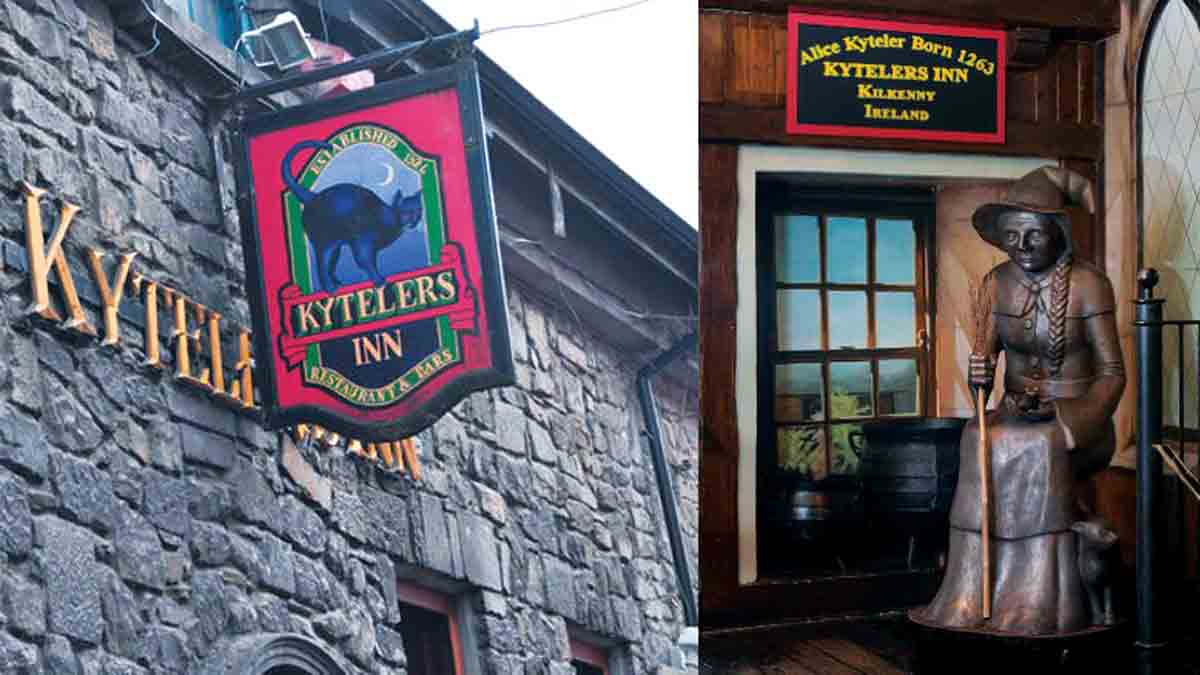BY JOHN FITZGERALD
PART ONE
Dame Alice Kyteler…After almost seven centuries, the name still sends a shiver up the spines of Kilkenny folk. Her name is linked to the shadowy world of the occult, and appears in hundreds of websites on the Internet devoted to psychic phenomena.
The mysterious lady was at the heart of Ireland’s first and only witchcraft trial. She also has the distinction of being “the one that got away.” Unlike so many of the women burnt at the stake in Europe for witchcraft, Alice thwarted her accusers and disappeared without trace from Kilkenny, never to be seen or heard of again in the county.
Today, the figure of Alice looms large in local folklore and draws vast numbers of tourists and sightseers to the Marble City. Kytelers Inn, the ancient tavern in Kieran’s Street associated with her, is both a popular eating-house and a prime tourist attraction. Its restaurant managers and bar men/women over the years have had to recite her amazing story to thousands of visitors.
Children walking past the Inn point and ask: Is that where the witch lived? In the pubs of Kilkenny, you can still hear lively conversations about Alice, the notorious witch trial, and the unresolved question of whether she really was a witch.
So who was Alice Kyteler, and what happened in 1324 that made Kilkenny famous throughout the world?
The Kyteler affair was sensational in its day: It had everything: Devil worship, sex scandals, power politics, inter-family strife, and a rift between church and state.
Dame Alice was an attractive, wealthy, and influential woman whose four marriages augmented the power and social status conferred on her by her own family connections.
Of Anglo Norman origin, she came to Kilkenny with her father who built a house, Kyteler’s Hall in Low Lane (Kieran Street). At a young age, she married the wealthiest banker in Kilkenny, William Outlaw. He died shortly afterwards, and Alice re-married.
Her second and third husbands also expired within a few months of her marriages to them. When her fourth husband, John le Poer, began showing signs of illness and a
“wasting disease”, rumours spread that she was slowly poisoning him, and that she had dispatched the other husbands in the same way. However, there was no evidence to support these claims.
Alice’s troubles began when her stepchildren turned against her. They accused their stepmother of bequeathing all her property to William Outlaw, a son of her first marriage and the only child she bore. They prevailed upon the Bishop of Ossory, Richard Ledrede, to charge Alice and her alleged accomplices with sorcery, witchcraft and heresy, “crimes” virtually unheard of in Ireland.
Ledrede relished the opportunity to get involved in a spot of witch hunting. While on the Continent, he had developed an obsession with heresy and the various dark deeds attributed to witches. He was anxious to unearth a few of them in his own Diocese and Alice seemed to fit the bill. His favourite book was a massive, badly written tome that railed against the evils of witchcraft.
Among other things, it suggested that “the sin of witchcraft stems from a woman’s insatiable carnal lust”. It claimed that women, if not properly supervised by their husbands, would get up to all sorts of mischief, such as bewitching men and casting spells to “diminish their manhood.” It condemned midwives and urged that they be persecuted without mercy. If a child was delivered safely, devilish powers were blamed, and miscarriages were also put down to “dark forces.”
Alice’s stepchildren invented the most ludicrous stories about her to fuel the Bishop’s enthusiasm.
They alleged that she sacrificed a cock to a “minor devil” called Robin at a crossroads outside Kilkenny and made contact with other demons that appeared in the forms of cats, shaggy dogs, and exotic beings. They claimed that Alice and her nefarious “helpers” slowly killed their husbands by black magic, using powders, and potions, and by cooking up stews that contained spiders, heads of decapitated thieves, chickens and “other detestable things.”
To be continued…




















